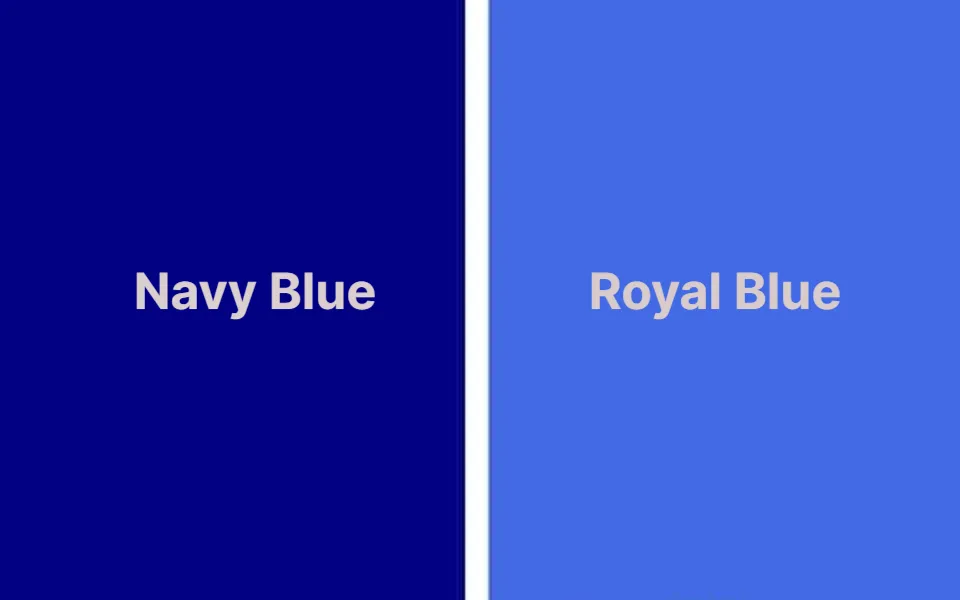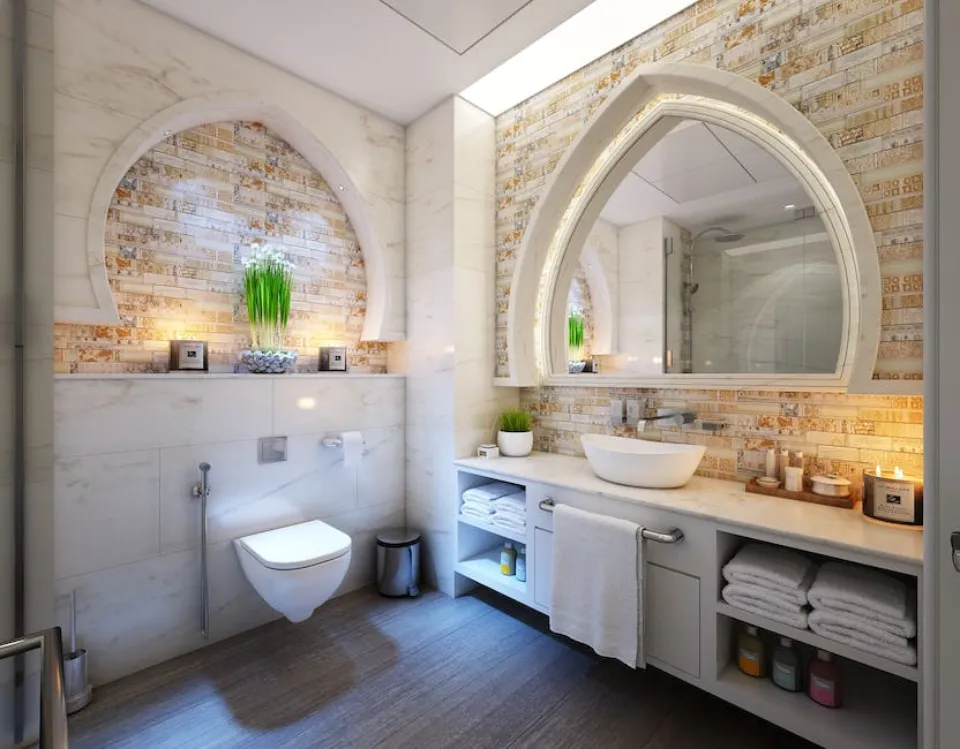If you’re considering doing it yourself,-painting part of your home, you want to make sure that you get it right the first time. There is very little margin for error when it comes to your time and money. Even though painting your cabinets seems simple enough, you might find yourself second-guessing your decision.
What is the best paint brush for cabinets?
The best paint brush for cabinets includes: Pro Grade Paint Brushes, Zibra Triangle Brush, Slobproof Paint Pen, Trimaco Paint Sponge, FoamPRO Paint Roller, Purdy Nylox Swan, Minwax Polycrylic 2-Inch Flat Stain Brush…
please read on for more detailed information.
Best Paint Brush For Cabinets
Here is a list of the best paint brush for cabinets:
Best Paint Brush Set—Pro Grade Paint Brushes
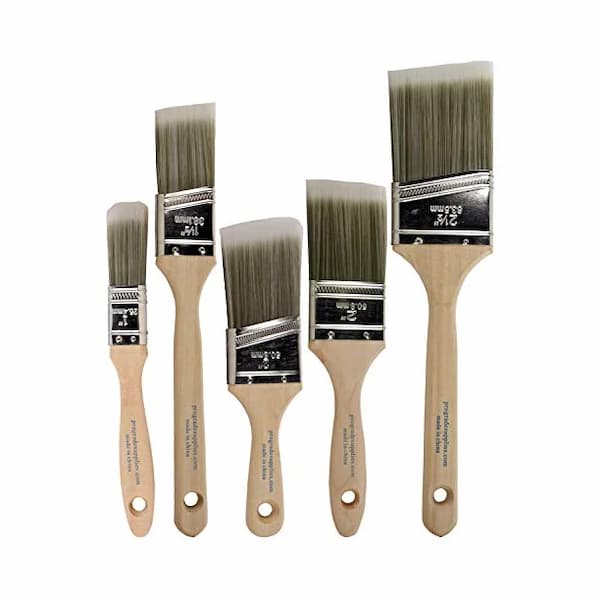
You can be ready for anything cabinet painting throws at you with the right set of brushes. Pro Grade’s five-pack of brushes comes in narrower, wider, and three slanted variations so you can work on any surface and get both thorough coverage and fine details. They contain solid round tapered filaments (SRT), which are smoother and hold their shape better than other materials. “I used these brushes to hand paint my kitchen cabinets,” wrote one reviewer. “Even painter’s tape wasn’t necessary for me. Since the edges are at an angle, I could easily move the paint to the desired location.”
Best Detailed Paint Brush—Zibra Triangle Brush
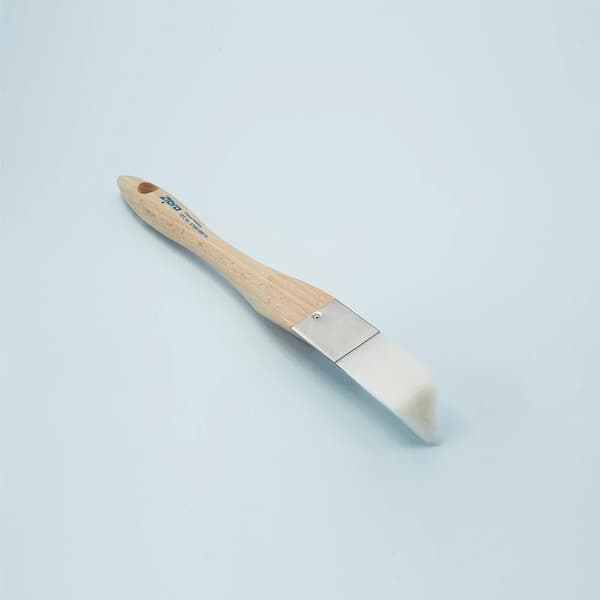
This highly regarded triangle model from Amazon’s Choice demonstrates that paint brushes don’t have to have flat, round, or angular heads. Whether you have Shaker, Windsor, or Colonial-style cabinets, this Grip-n-Glide triangular brush from Zibra’s intriguing collection of paint brush shapes can reach all the necessary spots. No matter how intricate or basic, the fine tip enables an even coat. “I get cramps in my hands pretty fast when I am cutting or working around a hard area like kitchen cabinets,” wrote one customer. “I completed the entire room with this brush in a single, thorough pass.”
Best Paint Touch-up Pen—Slobproof Paint Pen
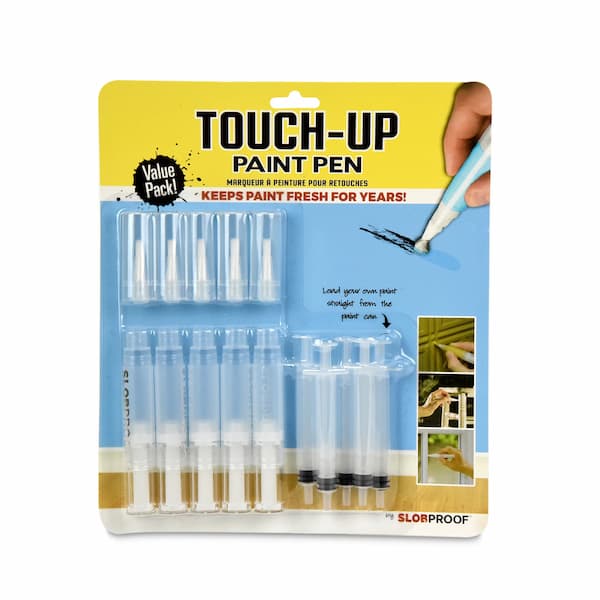
Accidents occur, and even if your cabinets don’t urgently require a fresh coat of paint, the inevitable scrapes and chips that accumulate over time can be removed with the appropriate tool. This pair of touch-up pens can be filled with paint and gently painted over any areas where lacquer is missing. You can control how much paint is released using the syringe on the back, and you can blend it in by using the brush. They can also serve you for several uses after a thorough wash. One cabinet refinisher leaves them with clients for emergency touch-ups, and another reviewer wrote, “I now have one of these for each of the two colors of my cabinets, and I can quickly pull them out.”
Best Stain Sponge—Trimaco Paint Sponge
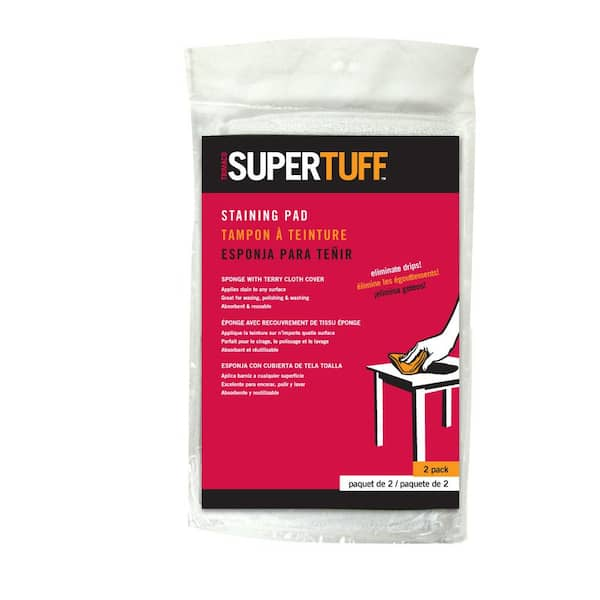
A sponge is a tool worth considering over a traditional brush if you decide to use a stain rather than paint. With their thinner consistency and easier control, Trimaco’s stain sponges are a huge help when applying and rubbing in stains. These inexpensive sponges can snag a little on uneven surfaces, according to some reviewers, even though the terry cloth can withstand some wear and tear. However, they work really well at removing stains and are very reasonably priced. “I’ve done a load of staining in my day but never has it been so effortless with these pads,” wrote one reviewer. “One was used for each layer of stain, and additional ones were used for the wipe-on polyurethane I was applying. Amazing.”
Best Paint Roller For Cabinets—Foampro Paint Roller
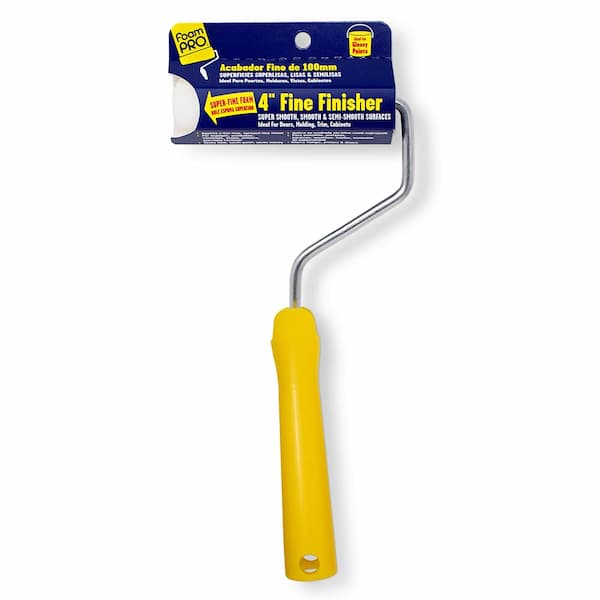
A smaller roller is best for working on cabinetry if you prefer to paint with rollers, though rollers in this case would work better on flat-faced cabinets. Thanks to its small four-inch frame and foam head, this FoamPRO roller gives you greater control when painting and prevents pointless splatters. “The roller handle is well made, comfortable to hold, and rolls smoothly,” wrote one satisfied customer. “A smooth finish that you could never achieve with a brush was left by the foam roller, which can hold a good amount of paint without being a dripping mess.”
Best For Large Areas—Purdy Nylox Swan
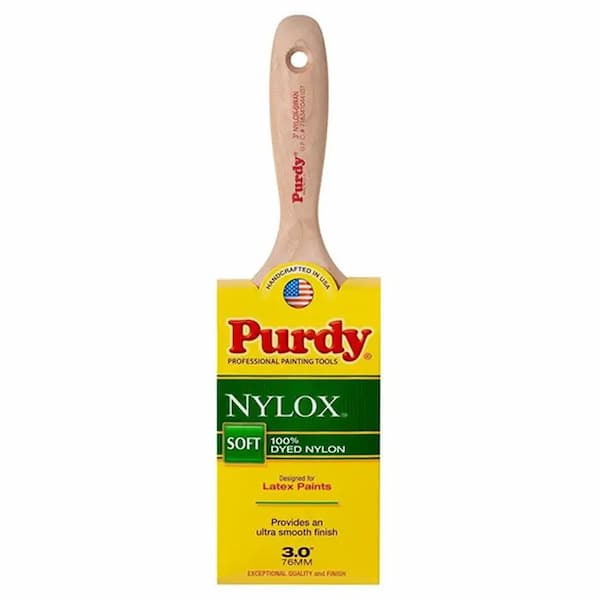
The Swan has the same 100% black nylon bristles that professionals vouch for from Nylox, one of Purdy’s premium paintbrush lines. This brush can save time and effort if you need to cover a large area and want a super-smooth finish. The soft bristles are made to smoothly apply paint while reducing the visibility of any lingering brushstrokes.
Because less paint is used, there is less chance of brushstrokes being created, which is what this brush is designed to prevent, so the brush pickup isn’t particularly good. The smooth hardwood handle of the Purdy Nylox Swan is another fantastic aspect. It has a nice taper in the middle that makes it simple and comfortable to hold.
Best For Nonpaint Finish—Minwax Polycrylic 2-inch Flat Stain Brush
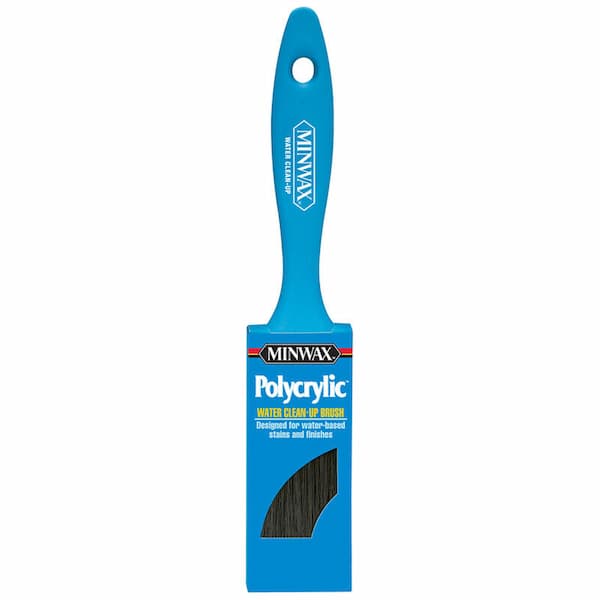
The likelihood of a woodworker’s cabinets being unpainted is fairly high. Many people prefer to keep their wooden cabinets’ natural appearance and let the direction of the grain speak for itself. If users want to achieve that, they may want to choose a clear or lightly tinted nonpaint finish. The final product is still greatly influenced by the brush used, just like in painting.
The brush from Minwax, a leader in the wood finish sector, is made to be dependable, efficient, and simple to maintain. The bristles are flexible enough to reduce brush marks, but stiff enough to give users the control they need to prevent creating high spots—a term for when the finish starts to build in a specific area.
There is no need to be concerned that the bristles will soak up all of an expensive finish because they were specifically designed for latex-based products. Despite being incompatible with oil-based finishes, these brushes are perfect for water-based ones, which are increasingly popular and preferred by professionals due to their ease of application and long-lasting results.
Best Cabinet Paint Roller—Work Tools International Whizz Velour Roller
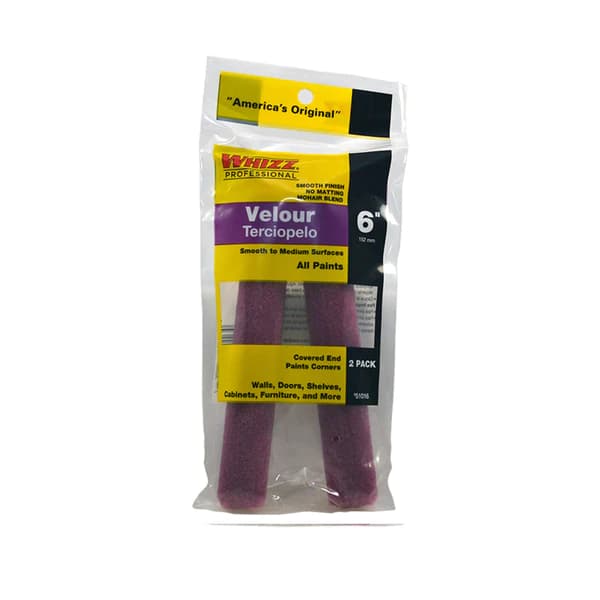
Because they are simple to maintain and can often speed up painting, rollers are preferred by many painters. The main disadvantages of using rollers are that they are difficult to maneuver and typically only suitable for wide planks. The Whizz Velour, on the other hand, fixes both of those issues. This roller is precise and easy to use thanks to its 8-inch handle’s appropriate size and 4-inch roller width. The best part is that its superior efficiency and speed characteristics have not changed.
Whizz Velour is a soft fabric that provides smooth, even coverage. Additionally, any roller marks that are left after the first coat can be completely hidden by the user with some simple overlapping; however, this roller leaves very few marks in the first place.
Best Cabinet Brush Set—Pro Grade 5-piece Paint Brush Set
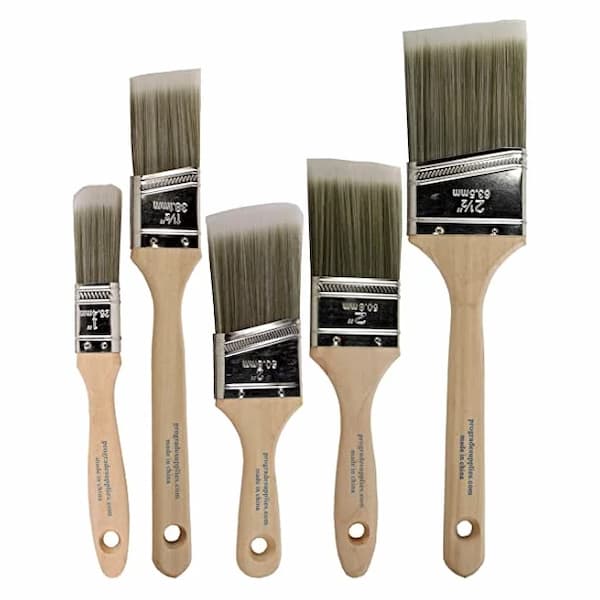
This Pro Grade set demonstrates that expensive paint brushes don’t have to be of the highest caliber. The Pro Grade set is designed for those who prefer to match their tools as closely as possible to the project at hand rather than trying to find a single brush that can do it all. Two flat brushes and three angled brushes in various sizes are included in the set, allowing users to easily trim pieces of various sizes as well as wide, flat surfaces. The solid synthetic round-tapered bristles on these brushes are another plus.
These brushes are simple to maintain because they are made to pick up as much paint as possible and release it as quickly as possible when it’s time to clean up, saving the user time. Additionally, each handle has an eyelet at the top that makes it easy to hang and store the brushes so that any excess liquid can drain out of the bristles facing downward.
Best High-quality Paint Brush—Purdy Paint Brush
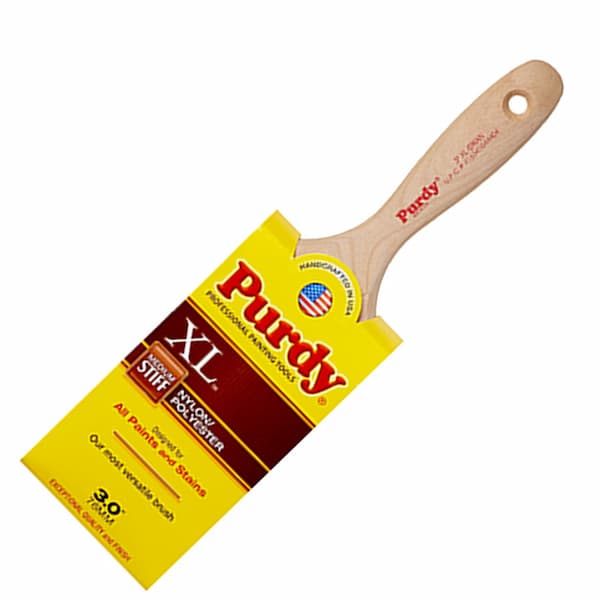
This Nylox edition, like all of Purdy’s high-quality paint brushes, is no exception. The difference is apparent despite the higher cost. The latex paints and semi-gloss finishes adhere evenly and are exceptionally well held by the thick nylon bristles, which also prevent visible brush strokes. You can find the ideal fit with the Nylox line, which ranges in width from a 0.2-inch brush up to a four-inch brush. “This type of brush is excellent for using with cabinet paint,” explained one pleased reviewer who further wrote that specialized cabinet paint is worth the extra expense as “it is self-leveling and cures harder than regular paint.”
Best Paint Brush For Latex Paint—Bates Choice Paint Brushes
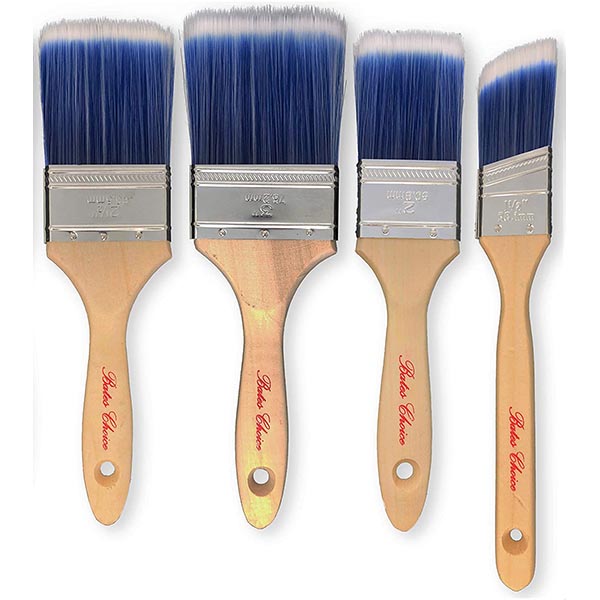
These Bates Choice brushes coat cabinet doors, frames, and interiors with ease thanks to their easily saturated synthetic filaments. A great set to keep on hand for different paint jobs is the angled brush and flat version, which offer lots of flexibility for getting into those tight corners. Many customers mentioned that their bristles stay put in the ferrule, and one wrote, “They are easy to clean, sturdy, [and] leave no brush lines,” further adding that the brushes made it possible to maneuver around knobs, too.
Best Chalk Paint Brush—Infiniti Elementz Paint Brush Set
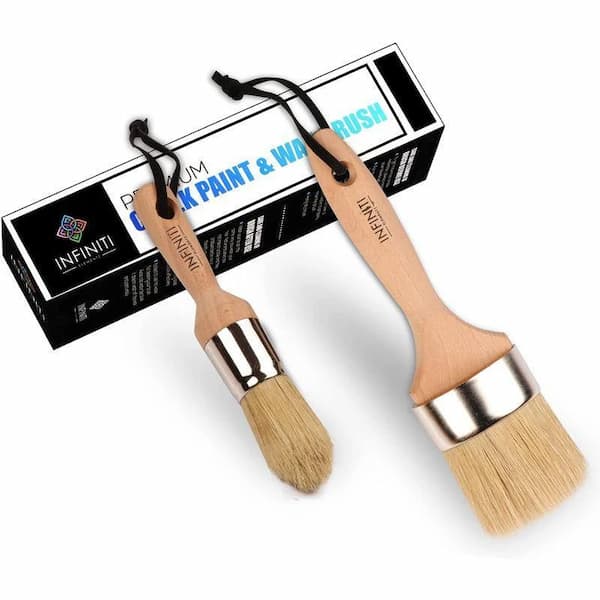
Working with chalk-finish paint is very different from working with other paints; you don’t always need primer, you use a specific kind of finishing wax, and you end up with a matte, powdery finish. With the help of this set of paint brushes from Infiniti Elementz, you can achieve the desired result. Once you’re done, the heads can help apply wax in addition to painting. They can be reused with the right care, and many customers discovered that they shed very little. “In addition to the unique small brushes, the large brush is essential for large areas without leaving brush marks and without a lot of brush loss,” wrote one pleased buyer. “The brushes are still flexible and prepared for the next task even after months of inactivity.” READ MORE: Best Primer For Kitchen Cabinets
Best Paint Brush For Trim—Wooster Brush
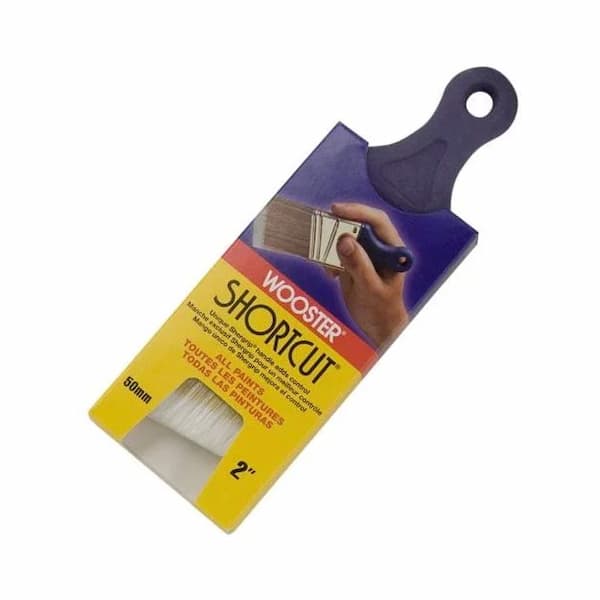
Having an angled brush in your toolbox will help you paint molding, trim, and sharp corners successfully. This angled Wooster Shortcut brush works well for cutting in and making sure you get into all the crevices while still allowing you to paint the entire cabinet. The best paints to use with its brush heads are oil-based and polyurethane ones. The handle is comfortable, according to buyers, especially for people with arthritis or limited mobility. “The handle flexes so you can paint all day long without hand fatigue, and the bristles are full and soft,” explained one satisfied customer.
Why The Brush Matters?
Many people reach for the first brush on the shelf when starting a cabinet painting project. But it’s obvious that your choice should have some thought behind it given the wide variety of brush styles, designs, materials, and other factors to take into account. Consider how your brush can make the project go more quickly when selecting one for your kitchen cabinet painting project.
Efficiency
Efficiency improvement is one of the main justifications for selecting the appropriate brush. After just a few minutes of painting, many people become exhausted. The project is frequently larger than anticipated when painting cabinets. More than just the doors, interior boxes, shelves, and occasionally even drawers frequently need painting as well. Working as quickly and effectively as you can will help you save time, energy, and paint supplies.
Applying paint faster, more evenly, and with less rework and product waste is possible with the right brush. The ideal brush will efficiently apply paint in layers while absorbing the right amount of paint. Efficiency is further enhanced by combining a variety of brushes made for various tasks. This entails choosing a variety of brush sizes and thicknesses for the various project areas.
Cost
Even money can be saved if the right tools are used. By increasing your return on investment, purchasing the right tools makes the entire project worthwhile. By choosing the right brush, you can save on direct and indirect project costs by:
- maximizing absorption and application to lessen the amount of paint required.
- less coats are required, thus.
- minimizing the duration so you can work on other tasks or projects.
- avoiding costly mistakes that call for more products or solutions to fix them.
- conserving pricey brushes for use in future home projects.
Your project will be more affordable if you select the proper primer, paint, stain, or finish for your kitchen cabinets along with the appropriate brushes. READ MORE: Best Primer For Kitchen Cabinets
Quality
A quality finished product is ensured by using the appropriate brushes when painting kitchen cabinets. The kitchen cabinets’ final appearance is greatly influenced by the brush you choose to use for the project. Without the proper brush, you might have to abandon the project and start over. Or you might find yourself having to live with a result you don’t like.
Since you lack the knowledge or experience to assist you if you’re a DIY beginner, picking the right brush is even more crucial. The best equipment for the job, including the appropriate set of brushes needed for cabinet painting, is preferred by seasoned painters. You can produce a high-quality result that avoids streaks, applies evenly, and looks good for years to come with the right tools.
Suggested reading: One of the best ways to quickly improve the appearance and ambiance of a space where you probably spend a lot of time is by updating your kitchen cabinets. So, how much does it cost to paint kitchen cabinets?
Considerations When Choosing The Best Paint Brush For Cabinets
When researching and selecting our final recommendations, we paid particular attention to the following considerations:
Type
Cabinet paint brushes come in a wide range of shapes and sizes and are made of a number of different materials. The fact that many similar products have conflicting and overlapping descriptions adds to the challenge presented by the sheer variety of cabinet paint brushes. When it comes to finding the right type, there are five main categories:
Natural Bristle
Natural-bristle brushes are typically more expensive than synthetic alternatives because they are made from animal hair, typically from horses, hogs, badgers, or a combination of the three. Ironically, even though we detest split ends in our own hair, the fact that natural hairs split is one of the main benefits of using natural brushes because the split allows the paint to be applied more smoothly. However, natural bristles can’t be used with water-based paint because the splits will absorb too much water, ruining the paint. Natural bristles are the way to go if customers are refinishing their cabinets instead of painting them with stain or a comparable substitute, like Danish or linseed oil.
Synthetic Bristle
Although high-end synthetic brushes can cost as much as, if not more than, their natural counterparts, synthetic bristles are typically less expensive. Natural bristles are more absorbent, but synthetic bristles are more adaptable because they can be used with both oil- and water-based finishes. Nylon or polyester are typically the materials used to make synthetic bristles, though many sizable manufacturers have created original bristle materials. Best-in-class cabinet paint brushes frequently have synthetic bristles that are a blend of materials, like nylon and polyester.
Hybrid
In a single sash, which is the technical name for the bristle group, hybrid bristles combine the best qualities of natural and synthetic bristles. In addition to the advantages of synthetic and natural bristles, such as reduced brushstrokes, hybrid brushes also offer greater longevity and better paint pickup. In hybrid brushes, the natural bristles are frequently shorter than the synthetic bristles, giving users some degree of control in some circumstances. Although they are less expensive than fully natural brushes, hybrid brushes should cost more than synthetic brushes.
Foam
Foam brushes offer a smooth finish and are absorbent. Although users might be able to squeeze two coats out of a single foam brush if they’re lucky, they are intended to be thrown away after a single use. Foam brushes have strong, clearly defined edges that produce clean lines. However, straight-stick handles found on foam brushes aren’t particularly comfortable, especially when used for extended periods of time.
Roller
Rollers are available in a wide range of widths and materials, such as soft cotton and firm foam. The use of rollers allows you to quickly cover a lot of flat, open space. Rollers are not ideal for cutting into or around tight spaces. As opposed to popular belief, rollers can also leave marks, so painters must still apply the final coats with caution.
Are you prepared for a kitchen update but not a complete remodel? An outdated kitchen can be revitalized by replacing the cabinets. So, how much do kitchen cabinets cost? Your chosen method of updating the cabinets will determine the precise cost of your new kitchen cabinets. According to national averages, it can cost anywhere between $2,946 and $5,435 to $7,113, depending on whether you just refinish them (change their color), replace them entirely, or resurface/reface them (apply new material on top of the existing cabinet frames and replace the doors and drawer fronts).
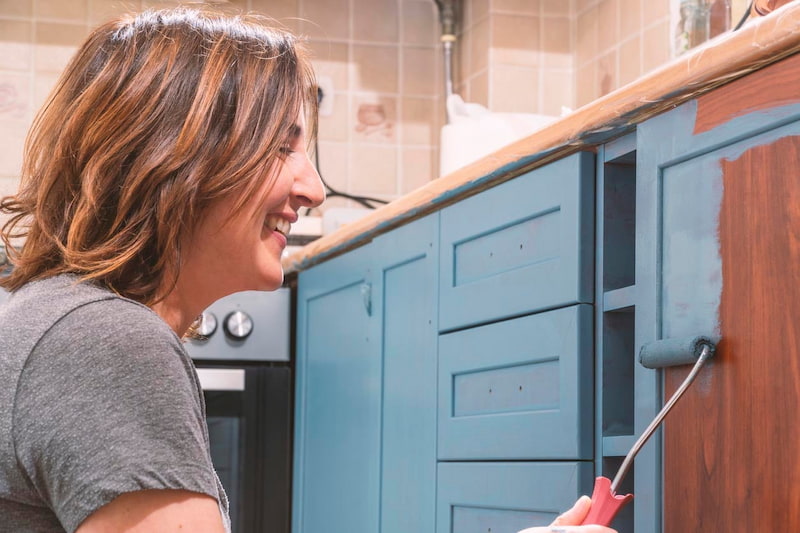
Firmness
Softer brushes offer a smoother finish because they reduce the visibility of brushstrokes, whereas firm brushes are easier to control and more precise. The bristles of softer brushes don’t have as much resistance and are more comfortable to use for extended periods of time, making them excellent for covering large areas. A medium-stiff brush that maintains its shape and offers the precision of a hard brush without leaving deep brush marks is preferred by many home painters, both professionals and do-it-yourselfers.
Size And Angle
There are many different sizes and shapes of paint brushes. There are thick and thin varieties, some are round while others are flat. Fortunately, however, there are only a few cabinet painting options available to users. Cabinet paint brushes typically have a flat sash with a chiseled edge to help create clean lines.
However, some cabinet brushes, also referred to as square brushes, are large and have thick, flat edges that can hold a lot of paint. These brushes are best for painting small details with the same color. As an alternative, brushes with angled edges work well for slicing into adjacent surfaces that will have contrasting colors.
For small spaces, angled brushes work best. Cabinet brushes typically come in widths between three and six inches. While less paint-holding and not nearly as effective for large projects, narrower brushes are easier to control and more precise than their wider counterparts.
Comfort
For cabinet paint brushes, comfort is essential, but there’s more to it than meets the eye. First and foremost, pay attention to the handle. People who frequently experience stiff palms after prolonged painting sessions should look at brushes with ergonomic or cushioned handles. Larger handles have the opposite problem in that they are more difficult to grip but may move around in the hand. Also, pay attention to how stiff the bristles are. Painters’ hands may quickly tire from exerting more force to use brushes with stiffer bristles. See more about Best Light Bulbs For Bathroom
Differences Of Brushes When Painting
The best way to paint cabinets is to think about the application, weigh the pros and cons of various brush types, and select the brush that best suits your cabinet’s requirements. The top application differences between different brush types include:
- Brush vs. roller: Depending on your personal preference, level of comfort, and level of expertise, you should either paint cabinets with a brush or a roller. If this is your first painting project, you might feel more at ease applying the majority of the paint with a mini roller and finishing the details with a small bristle or foam brush. Additionally, you can combine the two methods by painting with a brush and priming with a roller.
- Firmness: When painting cabinets, having enough firmness can help you achieve a smooth finish. Although more flexible and maneuverable, softer bristles are less effective at applying pressure evenly. A more effective tool, stiff bristles distribute paint more evenly and widely. Soft bristles are preferable if you’re staining cabinets rather than painting them.
- Size: When applying paint, the brush size has a big impact. To maximize efficiency and coverage, size should be matched to work surface size. You might need two different sized brushes for cabinets: one medium-sized brush to cover the main, broad surfaces, and a smaller brush for the narrow edges and any details like cabinet rails.
- Angle: Unlike rollers, which only have flat handles but can also have angled handles, brushes can either have flat or angled handles. For better application, angled brushes are some of the best to use when painting kitchen cabinets because they let you apply paint in a single motion from top to bottom. Specialty brushes also have angled handles to reach into cabinet back corners.
- Comfort: The comfort level is the last factor to consider when choosing a brush. Finding the right brush for your ergonomics is important because painting is a repetitive motion that can lead to cramping. Think about the handle’s length and the material, which can be metal, plastic, or wood. Shorter handles improve precision and direct the movement’s overall direction toward the wrist.
One of the best ways to quickly improve the appearance and ambiance of a space where you probably spend a lot of time is by updating your kitchen cabinets. So, how much does it cost to paint kitchen cabinets? The average cost to paint kitchen cabinets is around $750, ranging from $400 on the low end to $1,250 on the high end. Keep reading.
The Best Kind Of Brush To Use When Painting Cabinets
Angled sash brushes work best for painting cabinets. With projects involving working with raised panels and tight spaces, these brushes can help you maintain control. The best materials for the brush handle are rubber or wood, and you should check to see if it is designed to allow for a good grip. Here are some additional factors for your consideration when selecting the right tools for painting your cabinets:
- Nylon/polyester blends – These types of brushes ensure cleaner lines and help with paint distribution.
- Brushes with medium thickness – Choose a medium thickness for greater control because the brush’s stiffness has a significant impact on quality.
- Softer brushes for stains – Using a softer brush when staining rather than painting will improve the caliber of your work.
- Using a roller – If you decide to use a roller instead of a brush, choose one that is small (9 inches or less is ideal) and made of foam or mohair to ensure a smoother finish.
- Using spray paint – A HVLP (high volume, low pressure) sprayer will help reduce the amount of effort needed to do a good job if you’d like to use spray paint instead of a brush.
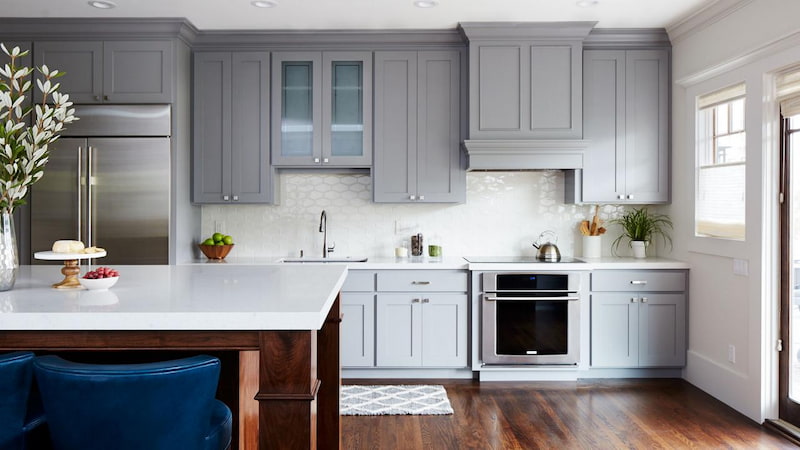
Which Is Better For Cabinets, Spray Paint Or Brush Paint?
If you want to paint cabinets with raised panels and guarantee a smooth finish all over, spray paint is a good option. However, if you’re only painting a few cabinets or are unaccustomed to using spray paint, paint brushes will work just as well. The amount of work required should guide your decision.
Regarding the spray paint vs. brush paint for cabinets debate, both are great options. The real difference between the two lies in how you actually paint your cabinets; both are guaranteed to give you a high-quality finish.
Choose Spray Paint If…
- The raised panels and difficult-to-paint areas on your cabinets are numerous.
- You’re engaged in a sizable project.
- You have the knowledge and time to practice using spray paint to effectively paint the inside of your house.
Choose Brush Paint If…
- Few or no raised panels can be found on your cabinets.
- You’re engaged in a modest project.
- Being certain of your painting’s accuracy is important.
- Using a brush instead of a sprayer gives you more confidence and comfort.
Eliminate Brush Strokes When Painting Cabinets
Despite the fact that painting the interior of your home can frequently seem like a simple task, doing it incorrectly can produce a shoddy appearance. If you want to know how to eliminate brush strokes when painting cabinets, these tips will help you:
- Clean the cabinets using soap and a clean rag – By doing this, you can prevent paint from contaminating your kitchen with dirt or other particles.
- Remove the cabinet doors from their hinges – On a flat surface, it will be simpler for you to carefully paint your cabinet doors.
- Sand both sides of your cabinets, and lightly sand in between coats – The surfaces will be better prepared for a new coat of paint thanks to this.
- Use a primer – In order to achieve a high-quality finish, primer helps paint adhere. READ MORE: Best Primer For Kitchen Cabinets
- Perfect your technique – As well as painting from top to bottom in a single stroke, make sure you’re using the brush’s angle to apply the paint (rather than holding it straight up and down).
- Paint in the same direction as the wood grain – Follow the wood grain to avoid creating texture if your cabinets are made of a heavy wood.
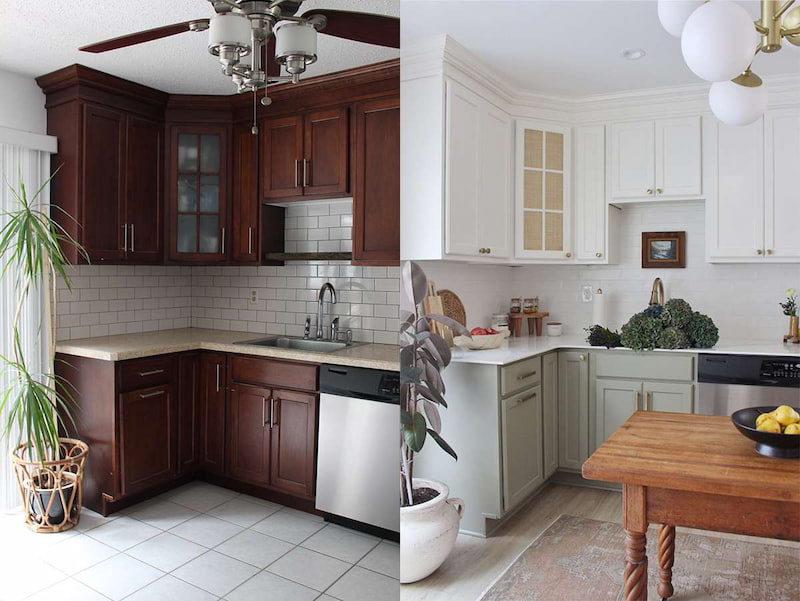
Tips For Using Paint Brushes For Cabinets
Painting cabinets is more difficult than it seems, whether they are in the kitchen or bathroom. Getting everything right can be difficult given the steps necessary for any DIY painting project and the specific methods required to achieve a stunning finish. However, if properly applied, a few quick tips can help one’s painting skills advance.
- To get the sharpest lines possible, approach corners and edges from below and arc upward toward the edge with the brush.
- Use the right quantity of paint for the brush; we advise tapping it twice or more against the side of the paint can or tray because too much paint leaves visible brushstrokes.
- Finishing strokes should be painted, if applicable, against the grain of the wood. Always move your brush back and forth across the same plane; don’t move it horizontally and then vertically.
You can learn how to install kitchen cabinets straight, solid, and true using these fundamental techniques. To begin with, you are supposed to prepare tools. Then, find the high point on the floor. We will show you how to install Wall/Upper Kitchen Cabinets, and Lower/Base Kitchen Cabinets.
General Tips For Painting Cabinets
- Prior to painting, make sure to remove all hardware, including internal hardware.
- When painting surfaces, use a grease-cutting cleaner, especially if you’re refinishing kitchen cabinets where spills and stains are common.
- On the side that isn’t being painted right now, use painter’s tape to number each cabinet face so you can remember where it goes.
- Once each coat is completely dry, sand in between to remove brushmarks and achieve the smoothest finish possible.
- To lessen the amount of dust in the air, vacuum both the surface of what you just sanded and the entire room you’ll be painting after the dust has settled.
Kitchen cabinets that smell great, look amazing, and are hygienically clean can be achieved by following our step-by-step guide cleaning procedure. So, how to clean kitchen cabinets? It’s easy. Just empty them out, tackle the tops, mix up a gentle cleaner, clean high to low, go at the grease, treat the trim, handle hinges and hardware right, get the glass gleaming, and clean the contents.
FAQs
Which Type Of Painting Tool Produces The Smoothest Finish?
Smoother finishes are achieved by using bristles that are softer, though softer isn’t always better.
I Need To Paint My Cabinets, How Many Coats Are Necessary?
All cabinets should receive at least two coats of paint and probably two coats of primer. Consider applying three coats of paint when painting cabinets that will see a lot of traffic.
What Happens If I Don’t Sand The Cabinets Before Painting Them?
Lack of sanding prior to painting will produce a rougher end finish if this is the first time the cabinets have been finished. Sanding is not necessary for every paint finishing project. Damaged, dented, chipped, or rough objects should be sanded.
Which Type Of Paint—Spray Or Brush—is More Effective For Cabinets?
The most popular DIY method for painting wood cabinets is brush painting because it is simpler, more intuitive, and requires fewer materials. The best paint brushes give painters more control over coat thickness, allowing them to produce a longer-lasting finish with thick coats in addition to being less expensive, simpler to set up, and easier to clean up. Brush painting, however, takes a lot of time and frequently leaves traces. Although it requires additional tools and has a quicker application time, spray painting offers smoother coverage.
Conclusion: Best Paint Brush For Cabinets
First and foremost, not all paintbrushes are created equal. Not even close.
I love to save money and get a good deal, but even I have learned that cheap paintbrushes are not the way to go.
Since they are made of low-quality materials and have rough bristles, they are inexpensive. With a cheap paintbrush, it is essentially impossible to achieve a truly smooth paint finish.
For real, take a look at this distinction. A no-name, low-quality paintbrush was used to paint the area on the left, and one of my favorite brushes was used to paint the area on the right.
Regarding your reading, I thank you.

